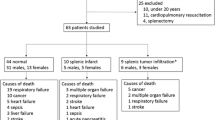Abstract
The spleen is composed of several tissue compartments and the respective histoquantitative data are essential for complete understanding of immune or pathological processes in this organ. The aim of our study was to determine and compare the stereologic parameters of all tissue compartments of the gunshot-injured and blunt-injured human spleen. The model-based stereology with point-counting method was utilized to study the volume densities of red pulp, perifollicular zone, marginal zone, white pulp (follicles and periarteriolar lymphoid sheath), and connective tissue. The areal numerical density (the number of follicles per mm2 of tissue section), the numerical density (the number of follicles per mm3 of tissue) of lymphoid follicles and the mean follicle diameter were also determined. Our study provides stereological parameters for all tissue compartments of the human spleen. No morphometric differences were registered between tissue compartments of the blunt-injured and gunshot-injured spleen. As the gunshot-injured spleen was taken as presumably unstimulated in immunological regard, our results suggest that both gunshot-injured and blunt-injured organs may be used as models of the normal human spleen.


Similar content being viewed by others
Abbreviations
- PALS:
-
periarteriolar lymphoid sheath
References
Adkins B, Charyulu V, Sun QL, Lobo D, Lopez DM (2000) Early block in maturation is associated with thymic involution in mammary tumor-bearing mice. J Immunol 164:5635–5640
Benedict CA, De Trez C, Schneider K, Ha S, Patterson G, Ware CF (2006) Specific remodeling of splenic architecture by cytomegalovirus. PLoS Pathogy 2:e16. doi:10.1371/journal.ppat.0020016
Drachenberg CB, Papadimitriou JC (1996) Splenic pathology in different forms of traumatic injury. Am J Clin Pathol 106:695
Farhi DC, Ashfaq R (1996) Splenic pathology after traumatic injury. Am J Clin Pathol 105:474–478
Ghosh P, Komschlies KL, Cippitelli M et al (1995) Gradual loss of T-helper 1 populations in spleen of mice during progressive tumor growth. J Natl Cancer Inst 87:1478–1483
Gunia S, Albrecht K, May M, Stosiek P (2005) The white pulp in the setting of the septic spleen caused by different bacteria: a comparative morphometric study. APMIS 113:675–682
Hollowood K, Goodlad JR (1998) Germinal centre cell kinetics. J Pathol 185:229–233
Kappler JW, Hoffmann M (1973) Regulation of the immune response. III. Kinetic differences between thymus- and bone marrow-derived lymphocytes in the proliferative response to heterologous erythrocytes. J Exp Med 137:1325–1337
Khanna KM, McNamara JT, Lefrançois L (2007) In situ imaging of the endogenous CD8 T cell response to infection. Science 318:116–120
Leemans R, Manson W, Snijder JA et al (1999) Immune response capacity after human splenic autotransplantation: restoration of response to individual pneumococcal vaccine subtypes. Ann Surg 229:279–285
Mebius RE, Kraal G (2005) Structure and function of the spleen. Nat Rev Immunol 5:606–616
Milićević NM, Cuschieri A, Xuereb A, Milićević Ž (1996) Stereologic study of splenic tissue compartments from traumatically injured and cancer patients. Gen Diagn Pathol 142:41–44
Milićević Ž, Cuschieri A, Xuereb A, Milićević NM (1996) Stereological study of tissue compartments of the human spleen. Histol Histopathol 11:833–836
Robinette CD, Fraumeni JF Jr (1977) Splenectomy and subsequent mortality in veterans of the 1939–45 war. Lancet 310:127–129
Segura JA, Barbero LG, Márquez J (1997) Early tumor effect on splenic Th lymphocytes in mice. FEBS Lett 414:1–6
Stamou KM, Toutouzas KG, Kekis PB et al (2006) Prospective study of the incidence and risk factors of postsplenectomy thrombosis of the portal, mesenteric, and splenic veins. Arch Surg 141:663–669
Sun QL, Charyulu V, Lobo D, Lopez DM (2002) Role of thymic stromal cell dysfunction in the thymic involution of mammary tumor-bearing mice. Anticancer Res 22:91–96
Weibel ER (1979) Practical methods for biological morphometry, vol 1. Academic, New York
Acknowledgments
Thanks are due to Jovanka Ognjanović for excellent technical assistance. This work was financially supported by the Ministry of Science and Technological Development of Republic of Serbia (project no. 145016).
Author information
Authors and Affiliations
Corresponding author
Rights and permissions
About this article
Cite this article
Milićević, N.M., Trbojević-Stanković, J.B., Drachenberg, C.B. et al. Stereologic Analysis of Tissue Compartments of Gunshot-injured and Blunt-injured Spleen. Pathol. Oncol. Res. 16, 69–73 (2010). https://doi.org/10.1007/s12253-009-9189-2
Received:
Accepted:
Published:
Issue Date:
DOI: https://doi.org/10.1007/s12253-009-9189-2




